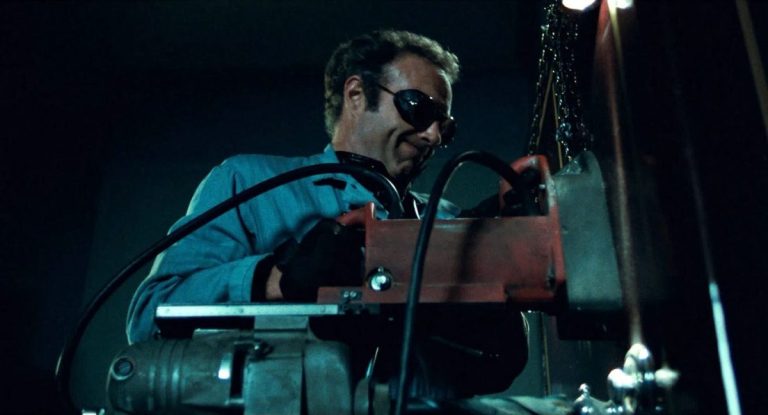Shell (2025), directed by Max Minghella, is a dark satire that mixes psychological horror with social commentary, showing the pressures women face in the entertainment industry. Elisabeth Moss plays Samantha Lake, a talented actress struggling with aging in a world that values youth above all else. Kate Hudson plays Zoe Shannon, the charming but dangerous head of a wellness company that promises eternal beauty.
The film has a strong David Cronenberg feel, using body horror to show the pressure on women’s bodies, and also references giallo horror and classic horror films with grainy, old-school camera work that feels retro and unsettling. While the style feels original, the story carefully critiques cosmetic surgery, ageism, and how female actors are replaced or sidelined as they get older. There are playful nods to the past: Hudson’s villainous role echoes her mother, Goldie Hawn’s iconic witchy character in Death Becomes Her, while Moss portrays a naive yet self-aware actress who knows her vulnerabilities but also stands her ground when needed.
The movie tries to be funny and bold, but the editing feels very inconsistent throughout. What is most distracting is that Moss’s possible pregnancy is hidden with a body double, but the effect is obvious and poorly executed. Despite these flaws, Shell delivers a strong message about the harsh realities women face in the entertainment industry. It shows how they are constantly judged for their age and appearance, controlled by unrealistic beauty standards, and often discarded once they no longer fit the industry’s narrow idea of youth and relevance.
In this article, I will discuss the ambiguous ending of Shell (2024) in detail. The article contains spoilers, and in case you haven’t seen the movie, it is best to stop reading now.
Shell (2025) Plot Summary & Movie Synopsis:
What happens in Max Minghella’s Shell (2025)?
Shell follows Samantha Lake, an aging actress whose career is fading despite her talent. She finds herself invisible in an industry obsessed with youth, a reality that affects countless female actors who are judged more for appearance than skill. The film quickly establishes the pressures of fame and beauty, creating a realistic backdrop for the horror and satire that follows.
Why does Samantha agree to the treatment?
After a lot of hesitation and talks with her best friend Lydia, Samantha discovers Shell, a high-end wellness company that promises treatments to keep people looking young and refreshed. Zoe Shannon, the company’s charming face, convinces her that the procedure is safe and groundbreaking. Encouraged by Dr. Hubert, a scientist working at Shell, Samantha decides to go ahead with it. At first, everything seems perfect: her skin looks radiant, her confidence comes back, and she is back in the public eye. Samantha quickly becomes the company’s poster girl, showing off the results of their treatment.
Samantha’s choice to undergo the procedure is rooted in desperation. Opportunities have dried up because of her age, not her talent. Dr. Hubert frames the treatment as cutting-edge and safe, promising a second chance at her career. The film emphasizes that Samantha’s consent is complicated by systemic pressures: refusing could mean permanent irrelevance. Her decision underscores a harsh reality for women in Hollywood, where compliance with beauty standards is often a prerequisite for survival.
However, the glossiness of her sudden fame and success soon begins to crumble. Samantha begins to notice black lesions forming on her skin, minor at first but increasingly alarming. At the same time, a young model named Chloe Benson, also a client of Shell, mysteriously disappears. The narrative pivots from glossy wellness fantasy to tense psychological and body horror, with the story exposing the literal and figurative costs of society’s obsession with youth. Samantha begins to uncover the horrifying truth: Shell’s treatments manipulate the human body at a fundamental level, modeled on crustaceans’ molting processes, forcing rapid skin regeneration at a dangerous pace.
What are the black growths on Samantha?
The black lesions are the body’s reaction to the accelerated and unnatural regeneration process. They are malformed tissue, visually representing the treatment’s failure and the dangers of tampering with the body. While initially minimized by the company’s doctors, their severity grows, serving as a physical manifestation of Shell’s hidden risks and the film’s body horror elements.
What happened to Chloe?
Chloe’s disappearance signals that Samantha is not alone in facing the consequences of Shell’s unethical practices. Her absence raises narrative tension and prompts Samantha to investigate further. Chloe’s fate foreshadows the extremes to which the company will go to maintain its façade and keep its clients under control.
How does Dr. Hubert help Samantha?
Samantha seeks Dr. Hubert for help after realizing the severity of her condition. In a private setting, Hubert immerses Samantha in a chemical solution designed to calm her lesions temporarily. The sequence shows Hubert’s moral complexity: he is part of the system but regrets the consequences, especially for Chloe. This scene also foreshadows the eventual reveal of Chloe’s fate
What deal does Shell offer Samantha?
As the dangers become evident, Shell attempts to regain control with a deal: lifetime treatment, financial benefits, and protection in exchange for Samantha’s silence. This illustrates the real-world power of corporations and their reliance on legal instruments, like NDAs, to protect their brand and suppress accountability. Samantha’s refusal sets the stage for the film’s climax and reinforces her agency as a character.

Shell (2024) Movie Ending Explained:
Is Samantha Able to Save Herself?
The ending of Shell resolves Samantha’s personal arc while leaving broader systemic issues unresolved. After rejecting Shell’s hush deal, Zoe brings Samantha to a secured room where Chloe is revealed. The once-human model has transformed into a grotesque crustacean-like creature, a literalization of the “molting” metaphor used throughout the movie. This moment blends body horror and satire, making Shell’s promises of eternal youth horrifyingly tangible.
Chloe’s escape triggers chaos, killing executives and attacking the lab staff. Zoe attempts to hide in a glass treatment chamber, which fails when Chloe smashes the equipment. Zoe dies inside, illustrating the irony of being consumed by one’s own obsession with perfection and control. Samantha, spared by Chloe, survives and becomes the moral center of the story. She publicly exposes Shell through interviews and a memoir, declaring she will no longer apologize for her appearance.
What does the ambiguous ending of the movie mean?
Despite Samantha’s personal triumph, Shell as a system survives. The company continues to operate, emphasizing that systemic power and societal obsession with youth are difficult to dismantle. Chloe’s fate remains ambiguous—she leaves the clinic, hinting at survival, vengeance, or disappearance. Her unresolved story reinforces the film’s themes of systemic exploitation and the lingering consequences of tampering with human bodies for profit.
Shell (2025) Movie Themes Analysed:
Ageism and the Entertainment Industry
The film highlights the harsh treatment of aging women in Hollywood. Samantha’s career stagnates not due to lack of talent but because she is older. Female actors are often replaced by younger talent or forced into cosmetic procedures to remain relevant. Shell exposes these pressures and literalizes them through its narrative, showing the extreme consequences of a system that values youth over skill.
Beauty, Consent, and Bodily Autonomy
The treatments promise eternal youth, but the cost is far greater than anyone expects. Samantha’s growing lesions, Chloe’s horrifying transformation, and Zoe’s death all show the real, physical and emotional toll of chasing society’s impossible standards of beauty. The film also asks a deeper question: can women truly consent when the pressure to look perfect comes from both society and their careers, pushing them toward choices that can be dangerous or even life-changing?
Corporate Secrecy and Control
Shell relies on NDAs, hush deals, and controlling corporate structures to keep its power intact. Samantha’s interactions with the company’s executives show just how vulnerable a person can be when up against such a system. Even at the end, when some truths are exposed, the company—and the system it represents—keeps going, which feels all too familiar in real life.
Body Horror as Social Commentary
The shocking transformations in the film aren’t just for scares—they reflect the way society exploits and pressures women. Chloe’s crustacean-like body becomes a haunting, literal example of what happens when female bodies are treated like commodities and unrealistic beauty standards are forced upon them. The horror works both physically and emotionally, making the audience feel the fear, shame, and loss that come with trying to meet a culture obsessed with youth and perfection. It’s a reminder of the toll such expectations take on real women every day.
Agency and Survival
In the end, we see Samantha surviving and thriving. She chooses to speak out, taking back control of her own story even though the system around her hasn’t changed. The film shows that standing up for yourself is possible, but real change in the industry or society needs more than just one person. The ending of the movie directs towards a mixture of hope and frustration, highlighting the gap between personal victories and the bigger, unchanging system.








